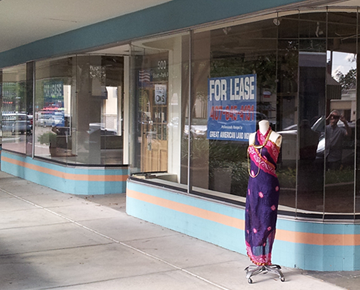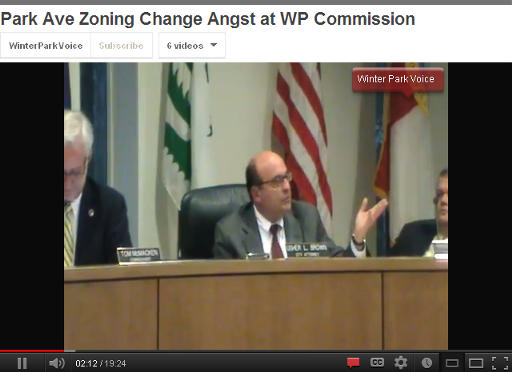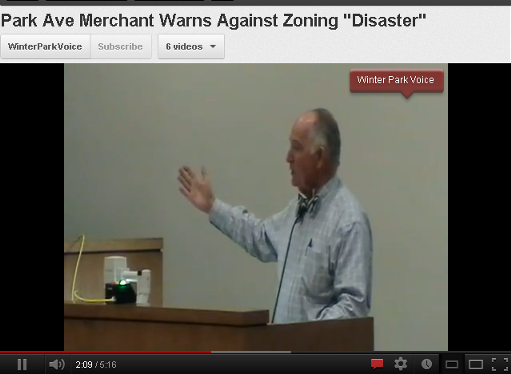 The city’s Economic Development Advisory Board (EDAB) is looking to inject a bit of life into the semi-deserted Park Avenue block just south of City Hall — by adding businesses that used to have a hard time getting approved for the avenue. The city’s Economic Development Advisory Board (EDAB) is looking to inject a bit of life into the semi-deserted Park Avenue block just south of City Hall — by adding businesses that used to have a hard time getting approved for the avenue.
A recent P&Z staff report supported the EDAB recommendation characterizing the five retail spaces on the avenue between Comstock and Fairbanks as inhabiting a “difficult” block that doesn’t quite fit in with the look and feel of the rest of the avenue.
On July 23, the city commission tabled he controversial proposal, which now sits in limbo at city hall waiting for commissioners to revive it — or kill it. At the commission meeting, the proposal ran into stiff opposition from citizens and commissioners. The citizen group included Park Avenue merchants who were angry that the city did not notify them of the proceeding — and who opposed allowing businesses on the avenue that do not fit a “shopping and fine dining” profile.
If revived, the proposal could alter the city’s C-2 zoning rules that currently discourage certain businesses from locating on Park Avenue — businesses including travel agencies, banks, government & medical offices, design studios, hair and nail salons, real estate offices, and licensed massage therapists. Some of these businesses are now located on the second floor of Park Avenue buildings, a use that is permitted under current rules.

It was the fast food-ish BurgerFi restaurant — approved for that block and just now opened, that convinced P&Z to consider changing the rules. The original P&Z staff report submitted to the P&Z board explains, “The city recently approved a new BurgerFi restaurant in that block . . . [BurgerFi has] table service and also an order counter for take-out. The experience has made the planning and economic development staff believe that in this one block, the zoning rules should be changed to allow all types of restaurants to be a permitted use.”
Planning & Zoning Board Approves Changes. City Commission Backs Away.
Continued from Home Page… On July 10, the Planning & Zoning board voted unanimously to change the zoning rules, but choked on the inclusion of fast food restaurants. Consideration of these restaurants was sent back to staff for further study. Since this change is technically an ordinance onto itself, a two-step process is required to secure final city commission approval — assuming that the commission decides to reconsider the proposal.
What exactly was the proposal tabled by the commission? According to Jeff Briggs, Director of Planning & Zoning, commissioners were being asked to vote to allow these businesses to apply for occupancy under “Permitted Use” rules. Technically, these businesses have always had the right to be considered for approval, but zoning regulations had forced them to apply under “Conditional Use” rules. Conditional Use is a longer, more arduous multi-step process that involves hearings and approval by Winter Park’s Planning & Zoning Board and the City Commission. These businesses must also verify that adequate additional parking is available to accommodate staff and customers. Park Avenue’s limited available parking is a high barrier of entry to these types of businesses.

Panera Bread, a casual dining, counter-service restaurant is one notable exception. Panera’s Conditional Use application was approved by board members and commissioners because the popular restaurant provides parking for customers in an adjacent parking garage — and because it was felt that they would be a good fit in their north Park Avenue location. Had Panera Bread been a “Fine Dining” restaurant with table service provided by servers, they likely would have qualified under the city’s zoning ordinance as a Permitted Use and could have avoided the hearings and special approvals. An important difference between Permitted Use and Conditional Use applications is that the Permitted Use classification does not require the city to give notice to the community — or seek community input — prior to approval of the application.
Because the proposed zoning change was tabled instead of being approved or denied, the matter remains an open question. Is a zoning rule change the best way to revitalize the neglected tail-end of Park Avenue? If approved, will this “open the door” to changes on the rest of the “Avenue”? These questions may never be fully explored in a future commission hearing, but will almost certainly be discussed down the block at Park Avenue’s popular new restaurant, Burger-Fi.
|
Recent Comments